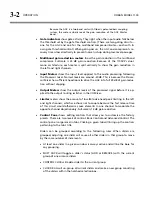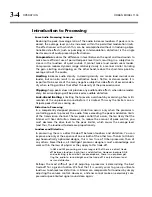
3-14
OPERATION
ORBAN MODEL 1100
you that you have chosen the optimum setting of the
L
ESS
-M
ORE
control, because
turning the control up to this point will cause the sound quality to become obviously
unacceptable.
You need not (in fact, cannot) create a sound entirely from scratch. All User Presets
are created by modifying Factory Presets or by further modifying Factory Presets
that have been modified previously. It is wise to set the
L
ESS
-M
ORE
control to
achieve a sound as close as possible to your desired sound before you make further
modifications at the Advanced Modify level. This is because the
L
ESS
-M
ORE
control
gets you close to an optimum trade-off between loudness and artifacts, so any
changes you make are likely to be smaller and to require resetting fewer controls.
In OPTIMOD-PC,
L
ESS
-M
ORE
affects only the dynamics processing (compression, limit-
ing, and clipping)—OPTIMOD-PC’s equalization and stereo enhancement are de-
coupled from
L
ESS
-M
ORE
. You can therefore change EQ or stereo enhancement and
not lose the ability to use
L
ESS
-M
ORE
. When you create a user preset, OPTIMOD-PC
will automatically save your EQ and stereo enhancement settings along with your
L
ESS
-M
ORE
setting. When you recall the user preset, you will still be able to edit your
L
ESS
-M
ORE
setting if you wish.
If you want to create a signature sound for your broadcast or netcast that is far out
of the ordinary, if your taste differs from the people who programmed the
L
ESS
-
M
ORE
tables, or if you are using OPTIMOD-PC in mastering or production applica-
tions, you will find Advanced Modify useful. At this level, you can customize or mod-
ify any subjective setup control setting to create a sound exactly to your taste. You
can then save the settings in a User Preset and recall it whenever you wish. This sort
of customization is usually unnecessary and inappropriate for sound for picture but
can be very useful for radio and production applications.
Compressor attack time, release time, and threshold controls are available. These
controls can be dangerous in inexperienced hands, leading you to create presets
that sound great on some program material but overdrive the look-ahead peak lim-
iter on other material, causing objectionable pumping or distortion. We therefore
recommend that you create custom presets at the Advanced Modify level only if you
are experienced with audio processing sound design and if you are willing to take
the time to double-check your work on many different types of program material.
In production and mastering applications, you will usually be working with one
piece of program material at a time. Here, you can use all of Advanced Modify’s
power to get the sound you want without being concerned about how your settings
will sound with other material.
The PC Remote software organizes its controls in tabbed screens. The first three tabs
(
E
QUALIZATION
,
S
TEREO
E
NHANCER
, and
L
ESS
-M
ORE
) access the Basic Modify controls.
The remaining tabs combine the Full Modify and Advanced Modify controls, logi-
cally organized by functionality.
Important Note:
Once you have edited a preset’s dynamics parameters
in Advanced Modify,
L
ESS
-M
ORE
control is no longer available in Basic
Modify. As noted above, we strongly recommend using the
L
ESS
-M
ORE
















































